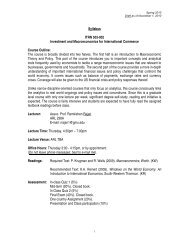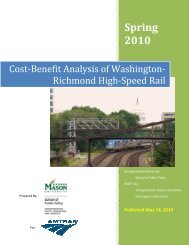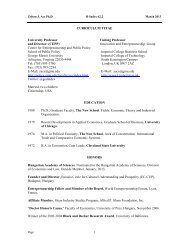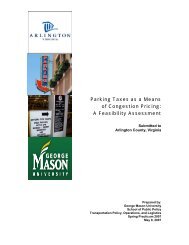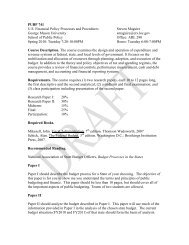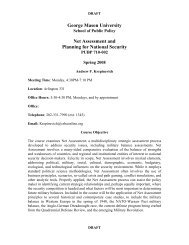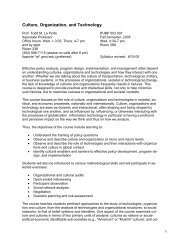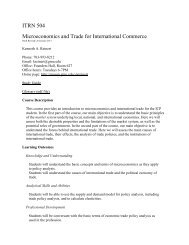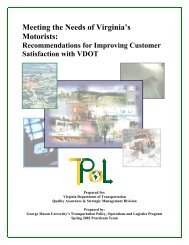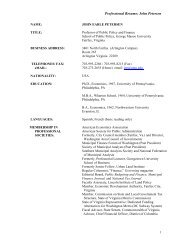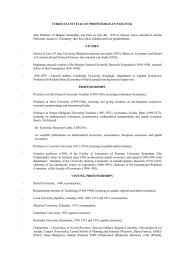Coordinating critical transportation infrastructure vulnerability
Coordinating critical transportation infrastructure vulnerability
Coordinating critical transportation infrastructure vulnerability
Create successful ePaper yourself
Turn your PDF publications into a flip-book with our unique Google optimized e-Paper software.
7.0 FINDINGS AND RECOMMENDATIONS<br />
The goal of this report was to develop a product designed to assist WMATA in conducting a selfassessment<br />
of its <strong>infrastructure</strong> security required for the National Capital Region by the Homeland<br />
Security Act of 2002. Additionally, it provides recommended prioritization methodologies to assist<br />
WMATA in allocating time and resources to security related improvements at the regional level. To<br />
complement the Regional Emergency Coordination Plan (RECP) and the FTA's WMATA<br />
<strong>vulnerability</strong> assessment, this report also describes various tools available today of the scope and<br />
type most useful for WMATA's needs.<br />
The RECP was designed to allow regional governments in the National Capital Region to effectively<br />
plan, communicate, coordinate, and share information during actual emergencies. As described, the<br />
RECP is comprised of the Regional Incident Communication and Coordination System (RICCS),<br />
Regional Emergency Support Functions (R-ESFs), and associated annexes, all of which provide the<br />
coordination framework needed during such an emergency.<br />
WMATA has one of the most complex tasks for <strong>vulnerability</strong> assessment as it operates rail and bus<br />
services in the majority of the COG jurisdictions. Through this vast region, it must coordinate with<br />
18 separate governments located throughout Northern Virginia, Maryland, and the District of<br />
Columbia ensuring the same level of coordination takes place throughout the region regardless of<br />
jurisdiction. For example, WMATA must make certain the response to a potential incident in<br />
Montgomery Co. Maryland must be as planned and coordinated as one in Arlington Co. Virginia.<br />
Guaranteeing that type of seamless coordination is a daunting task.<br />
One of the recommended methods WMATA can use to comply with Homeland Security Act of<br />
2002's intent and plan cohesive responses across those many jurisdictions is the use of a selfassessment<br />
tool. As described in Chapter 4, there are multiple tools available and in use to evaluate<br />
<strong>infrastructure</strong> security and recommend corrective action when needed, but none are specifically<br />
designed to address compliance with the Homeland Security Act. After assessing the attributes of<br />
the 15 tools selected for review, the WashCOGs RECP scored in the highest category, "robust", for<br />
addressing all four response phases and attaining at least 15 "high" marks in addressing evaluation<br />
criteria.<br />
Although all of the 15 tools reviewed have individual merit, none comprehensively fit WMATA's<br />
particular need. This led to the development of the Hybrid Tool described in Chapter 5. This<br />
hybrid was developed specifically for the <strong>critical</strong> <strong>infrastructure</strong> needs and assessments in the<br />
National Capital Region. The tool is designed in a checklist format for ease of use and is broken out<br />
by five categories (Planning & Prevention, Response, Recovery, and Mitigation). Each of the<br />
questions listed under these categories was specifically selected and tailored to address WMATA's<br />
needs. This tool, in conjunction with the RECP, will take WMATA through the necessary steps<br />
towards compliance with the requirements of the Homeland Security Act of 2002.<br />
Once WMATA defines its specific needs for compliance with the Homeland Security Act of 2002,<br />
prioritization is <strong>critical</strong> to efficiently utilize the limited resources for the greatest good. Chapter 6<br />
discusses the various quantitative and qualitative methods recommended for use in needs<br />
prioritization such as Cost Benefit Analysis (CBA), Goals Achievement Methodology, and Security<br />
Risk Index Methodology. The Goals Achievement Methodology is the recommended approach as it<br />
PUBP 710/722 Page 45 of 60<br />
WMATA Case Study June 5, 2003



